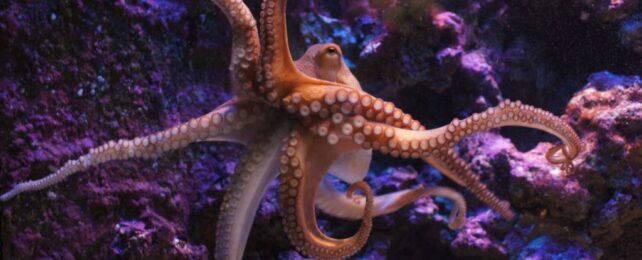To look at them, squids and octopuses seem to have a lot in common. Both are soft, squishy, marine-dwelling animals with eight sucker-lined arms and a fascinating level of intelligence.
But the last common ancestor between the two was around 300 million years ago. Since then, squids and octopuses have forged their own evolutionary paths, leading to some fascinating differences in their adaptations. And one of these, scientists have now discovered, is how they taste the world around them.
Research published in 2020 showed that octopuses can taste the world around them through special receptors in their suckers. At the time, it seemed that squids did not have the same ability.
Now new research, laid out in two separate papers, has revealed what substances, precisely, octopuses' receptors are attuned to – and that squids, also, have taste sensors in their suckers, but that they're attuned to a different kind of flavor more appropriate to their lifestyle.
"Thus, cephalopods," the researchers write in one paper, "provide notable examples of convergent and divergent evolution that can be exploited to understand the molecular basis of novelty across levels of biological organization."
In the course of conducting the 2020 research in the laboratory of Havard University molecular biologist Nicholas Bellono, researchers noticed that octopuses seem to have the ability to detect materials that aren't very soluble in water, like grease and oil. So those researchers combined forces with neurobiologist Ryan Hibbs of the University of California San Diego to dig deeper into the mystery.
In the first study, the researchers describe, for the first time, the structure and workings of the receptors in octopus suckers. These are chemotactile receptors – ones that combine the senses of taste and touch, like if your finger was also a tongue (ew).
They consist of a group of proteins clustered together to form a tube-like structure – which is, the researchers found, extremely similar to receptors found in humans.
In the case of humans, these structures are neurotransmitter receptors found in the brain and muscles. In the octopus (the California two-spot octopus, Octopus bimaculoides), they help describe the world around it. This makes a lot of sense.
Have you ever watched an octopus? They reach out with their arms, feeling their way around, searching for prey using touch and taste.
Because of the brain-like networks of nerve cells are distributed throughout their body, the arms are then able to make decisions based on what they sense.
"In octopus, we found that these chemotactile receptors physically contact surfaces to determine whether the animal should eat a potential food source or reject it," Hibbs explains.
"Through its structure, we found that these receptors are activated by greasy molecules, including steroids similar to cholesterol. With evolutionary, biophysical, and behavioral analyses, we showed how strikingly novel structural adaptations facilitate the receptor's transition from an ancestral role in neurotransmission to a new function in contact-dependent chemosensation of greasy environmental chemicals."
In other words, the receptor used to be involved in neurotransmission, but it evolved to help octopuses use their arms to search the seafloor and crevices for things they might like to eat.
Squids function very differently. These cephalopods are ambush predators, lying in wait, shooting out their eight arms and two tentacles to snare passing prey. In a second paper, researchers found that striped dumpling squids (Sepioloidea lineolata) also possess taste receptors in their suckers (although significantly fewer of them than octopuses have) – and they sense bitter flavors.
Researchers conducted experiments to determine why this might be. They found that squids were more hesitant with, or outright rejected, food coated with a bitter compound, suggesting that the taste helps the animals work out what is and isn't edible.
Finally, the researchers studied the animals' genomes and found that the two different chemotactile receptors had emerged after squids and octopuses diverged. So they independently developed in the two different animals, which played a significant role in driving their different hunting strategies.
"We discovered a new family of cell surface receptors that offer a rare lens into the evolution of sensation because they represent the most recent and only functionally tractable transition from neurotransmitter to environmental receptors across the entire animal kingdom," Hibbs says.
"Our structures of these unique cephalopod receptors lay a foundation for the mechanistic understanding of major functional transitions in deep evolutionary time and the origin of biological novelty."
Indeed.
The two papers have been published in Nature. They can be found here and here.
